Researching the politics of development
Blog

Thinking and working with political settlements
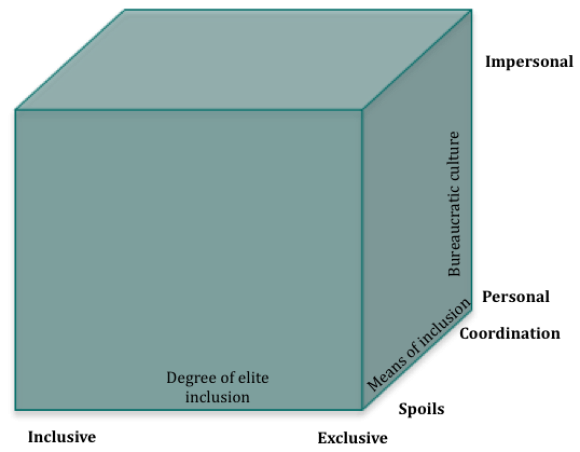
This article aims to give some advice to development practitioners, especially those working in-country, on how to use Political Settlements Analysis (PSA) as a diagnostic tool for country programming. This advice draws on cutting-edge political settlements work to provide a simple set of questions that can help country staff identify the type of settlement they are working in and to draw some broad operational implications.
It should be stressed that it is in the nature of PSA to provide only rough rules of thumb, not detailed directions, for action. Nevertheless, in our view, PSA has the potential to provide, if not a road map, then some compass bearings for policy.
Background: political settlements in theory; political settlements in development agencies
The term ‘political settlement’ is of fairly recent origin. One of the first traceable uses is in Joseph Melling’s study of industrial capitalism and the welfare state (Melling. 1991); in 1995, Mushtaq Khan used it in a development studies context to analyse the performance of institutions; it was later used by Fritz and Rocha Menocal (2007) and Whaites (2008). The idea subsequently caught on in the development community, with notable contributions from Khan (2010), di John and Putzel (2009), Lindeman (2008), Jones et al. (2012), The Asia Foundation (Parks and Cole, 2010), the Developmental Leadership Programme (Laws, 2012; Laws and Leftwich, 2014; Rocha Menocal, 2015), the Danish Institute for International Studies (Whitfield and Therkilsden, 2011) and the Centre for Effective States and Inclusive Development (Hickey, 2013; Levy and Walton, 2013), among others.
Much of this work has been funded by aid agencies, including the UK Department for International Development (DFID), the Australian Agency for International Development (AusAID, now the Department of Foreign Affairs and Trade (DFAT)), the Development Assistance Committee of the Organisation for Economic Co-operation and Development (OECD-DAC) and the World Bank. Some has found its way into policy documents, and, to a lesser extent, programming. For example, strengthening political settlements was a pillar of DFID’s 2010 Building Peaceful States and Societies report (DFID, 2010), and was a cornerstone of the World Development Report in 2011; subsequently, it was a central element in DFID’s Country Poverty Reduction Diagnostic (DFID, 2013).
At the heart of PSA is the idea that societies cannot develop in the midst of all-out violence or civil war; yet the way different societies solve the problem of violence, the political settlement they craft, creates powerful path-dependencies for the way they do or do not subsequently develop. And while different authors and organisations have defined ‘political settlement’ in slightly different ways, there is increasing convergence around the idea that PSA is about understanding ‘the formal and informal processes, agreements, and practices that help consolidate politics, rather than violence, as a means for dealing with disagreements about interests, ideas and the distribution and use of power’ (Laws and Leftwich, 2014: 1), and that these will play out across two levels, involving both intra-elite and elite-non-elite relations (Laws, 2012).[1] A major implication of PSA is that, since replacing one political settlement with another is normally a very difficult or risky business, successful development practice involves some kind of adaptation to these formal and informal processes, practices and power balance, and their associated path-dependencies.
While increasing numbers of development practitioners would probably accept PSA’s tenets, the approach, as currently configured, seems difficult to operationalise. Informal contacts with aid agency staff suggest that, although many are sold on the idea that ‘the political settlement’ is a crucial factor in development, it is not clear whether PSA is really making a difference or simply providing a new language in which to dress up conventional governance programmes, such as national dialogues, formal institutional reforms, empowerment and accountability projects and so on.[2]
Thinking and working with the political settlement
By placing politics at the centre of development policy, PSA has a natural affinity with a number of other approaches currently popular in development circles. The Thinking and Working Politically approach to development, championed by the Development Leadership Programme (DLP) and DFAT, among others, rests on the idea that, because development policies affect who gets what, when and how, they create coalitions in support of or opposition to them (Leftwich, 2011). Good policymaking involves getting to grips with these coalitions. The Overseas Development Institute’s (ODI’s) Adapting Development approach implies having a proper understanding of the interests aligned for and against a specific policy, a much better overview of historical legacies and current realities and the ability to identify those individuals and groups well placed to bring about positive, frequently incremental, change (Wild et al., 2015: 8). Often, this involves working in an adaptive, entrepreneurial way, placing ‘small bets’ on different solutions and learning quickly from mistakes (ibid.). Some of the tools being proposed for this way of working include Matt Andrews’ Problem-Driven Iterative Adaptation (PDIA), and Lant Pritchett et al.’s Crawling the Design Space, the latter involving trying out new things, in context, until something works (Pritchett et al., 2013). Recently, these approaches and others like them have been championed by the Doing Development Differently (DDD) network, which brings together diverse individuals, groups and disciplines with shared frustrations about the frequently disappointing results of development aid.
While the emphasis on experimental, entrepreneurial development is to be welcomed, one of its shortcomings is its comparative lack of advice for development practitioners on where to start ‘placing small bets’. Just as we would expect a punter who arrived at a racecourse knowing nothing about the horses, their form or the conditions underfoot to lose a packet, so we believe DDD practitioners starting from a completely blank slate will be more prone to making the wrong choices. Admittedly, there have been some useful attempts from within the PDIA stable to differentiate between different types of context, as well as different types of problem and intervention, but so far these have been limited to distinguishing between contexts that are ‘stable’ or ‘dynamic’, or those in which practitioners can have ‘high’ or ‘low’ confidence (Barder, 2012). PSA, we suggest, can provide an additional means of distinguishing meaningfully between country contexts, and a useful starting point for identifying priority areas in which to work and kinds of partner with which to work. We call this thinking and working with the political settlement.
Our approach draws on work being done by: Bruce Jones et al. (2012), who see the degree of horizontal (elite) inclusion in the political settlement as a major determinant of state fragility; David Booth (2015), who provides a framework for understanding development pathways by reference to whether ruling elites choose to include rival elites into the political settlement by means of either spoils distribution or what he calls ‘purposive coordination’ around a common vision or goal; and Brian Levy, who uses institutional, and especially bureaucratic, culture to differentiate settlement types (Levy, 2014; Levy and Walton, 2013).
Simplifying and synthesising these different approaches, we have devised a set of diagnostic questions for policymakers, the answers to which will allow them to locate a settlement in the three-dimensional space the cube below depicts. Although it is certainly possible to conduct very meticulous research into political settlements, ‘good-enough’ answers to these questions can also be obtained in a fairly economical way. Development practitioners should read relevant background literature, much of which may have been produced in-house, consult experts on the country’s politics and hold focus groups with key informants from business, civil society, the media and the development community; they should be looking for a rough idea, rather than a precise measurement, of where a settlement stands on each dimension. This is partly because knowing what kind of settlement one is in is just a first step in devising a more detailed way of working, which will involve additional and ongoing forms of political economy analysis (PEA) and should anyway be somewhat adaptive and experimental.[3]
The political settlements 3-D space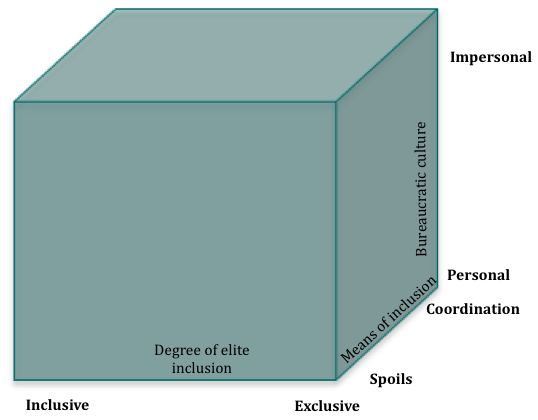
Diagnostic questions
Now that we have our 3-D space or cube, we can ask three diagnostic questions that will allow us to plot the location of specific country political settlements within it, and infer some basic operational implications:
- How inclusive/exclusive is the political settlement?
I: The majority of elites[4] accept the settlement and have foresworn the use of violence to achieve their aims.
E: Only a minority of elites accept the settlement, meaning most remain willing to use violence to achieve their aims.
The answer to this question allows us to plot a point on the width of the cube, and is a major predictor of state stability. Other things being equal, more inclusive settlements will be more stable and less inclusive ones will be more prone to conflict, instability and possibly collapse (collapse being indicated by a situation of all-out conflict or war).
- What motivates elites to accept the political settlement?
C: They are coordinated around a common purpose.
S: They are given a share of spoils.
If the width of the cube represents the degree to which elites buy into the settlement, the second question is about the means of inclusion, or the way this buy-in is achieved, and it allows us to plot a point on the depth of the cube. We distinguish between individualised pay-offs at one end of the spectrum and what we call ‘purposive coordination’ at the other. In pay-off settlements, elites are induced to keep the peace, primarily through access to economic rents (policy-induced revenue streams) or spoils. In purposive coordination settlements, by contrast, elites are coordinated for some common purpose, be it nation-building, external warfare or inclusive development. There may be an expectation of benefits down the line, but these do not take the form of interpersonal quid pro quo exchanges; indeed, there may be a considerable degree of short-term self-sacrifice involved. The degree of coordination is a major predictor, we believe, of a settlement’s ability to supply public and collective goods over and above internal peace, since it provides a mechanism not only to forge consensus on common goals but also to prevent free-riding and shirking.
- By what norms is the bureaucracy governed?
I: Impersonal rule-following and meritocracy;
P: Patron–client relations and nepotism.
Answers to this question allow us to plot a point on the height of the cube. At one end of the spectrum is a bureaucracy governed by personalised norms, such as nepotism, clientelism and patronage. At the other end are impersonal norms, rules and meritocratic recruitment. While the width and height of the cube refer to intra-elite relations, this dimension has important implications for the way the elite incorporates non-elites. Does it do so by supplying jobs and services as patronage favours or pork-barrel hand-outs, or does it do so by impersonally supplying public goods and services according to rules? Other things being equal, the more impersonal the bureaucracy, the more likely it is to be able to supply genuinely public goods and services at the frontline.
Answers to all three questions combined will yield a cube or cuboid within the 3-D political settlements space, representing the concrete characteristics of a particular political settlement. The extent to which the cuboid fills the space, and the way it does so, provides an intuitive means of predicting a settlement’s developmental potential, and also, as we shall see, some pointers for how to think and work politically.
Some easily recognisable political settlement types
Because each axis represents a continuous, not a categorical, variable, the number of possible cubes is infinite. It is possible, however, to identify some easily recognisable ‘ideal types’, which provide a good starting point for policymakers.
Inclusive, coordinate, impersonal settlements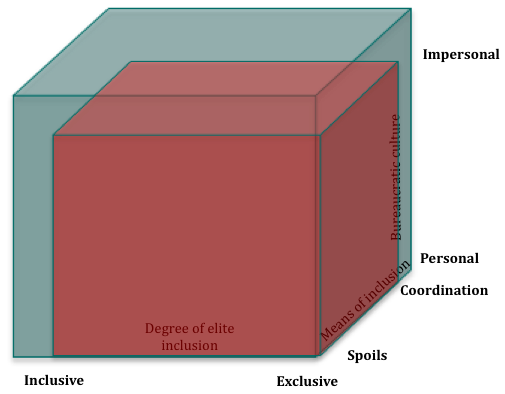
In this type of settlement, the most important elites have been incorporated and are coordinated around a common purpose. The bureaucracy also functions according to impersonal, meritocratic rules. In consequence, the settlement should have a high degree of at least incipient development capacity, and development partners are most likely to add value by supplying funds and technical expertise to the government, in areas where it currently lacks them. The leadership may, however, have certain blind spots, and development partners may wish to offer evidence and advice on these various issues.[5]
Inclusive, coordinated, impersonal-type settlements are not particularly common in today’s developing world, but classic developmental states of the post-war era, such as South Korea, approximated this model, and we suggest Mauritius and Rwanda are plausible contemporary examples.
Exclusive, spoils-driven, personalised settlements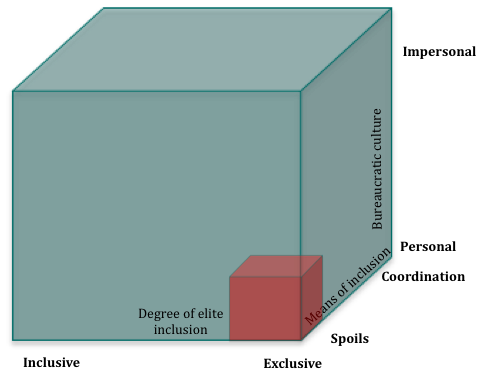
The next type of settlement occupies the opposite extreme to the previous one. Only a minority of elites accept the settlement’s terms, held together mainly by access to spoils, and personalistic, clientelistic norms govern the bureaucracy. These settlements will be under constant threat of conflict, if not conflict itself; elites will be unable to act collectively for common ends; and the bureaucracy will be incapable of supplying public goods effectively. In these circumstances, the most rapid developmental gains are likely to be made possible, in the first instance, by making the political settlement more inclusive, and development partners may wish to concentrate their energies on brokering these kinds of deals. The dilemma, however, is that, if the main means of making the settlement more inclusive is simply a wider distribution of spoils, the developmental potential of the settlement will remain limited. Further, spoils-based settlements tend, in general, to be more fragile than coordinated settlements, since external shocks or internal realignments can easily upset the geometry of rewards.
In consequence, it is probably worth at least asking the question of whether a more purposive kind of settlement can be found, and what it would take to achieve it. Innovative arrangements for the management of extractive rents, for example, may both reduce some of the incentives for spoils politics at the same time as providing the finances to turn a more purposive vision of development into reality, even if experience suggests such arrangements can be difficult to sustain. In the meantime, development partners are best advised to attempt ameliorative development policies with non-state actors—cognisant of the fact that such support can also prolong conflict—while providing the minimum kind of support necessary for state stability. They may also wish to explore gradually augmenting state capacity by supporting islands of effectiveness, the idea being that state effectiveness can be built incrementally at first, and that this may provide the kind of demonstration effect necessary to changing elite mindsets, and in turn the political settlement itself. Comprehensive public sector reform programmes and the like, however, are highly unlikely to succeed.[6]
Unfortunately, these kinds of settlements are not uncommon in today’s developing world, the Democratic Republic of the Congo being an archetypal case.
Hybrid settlements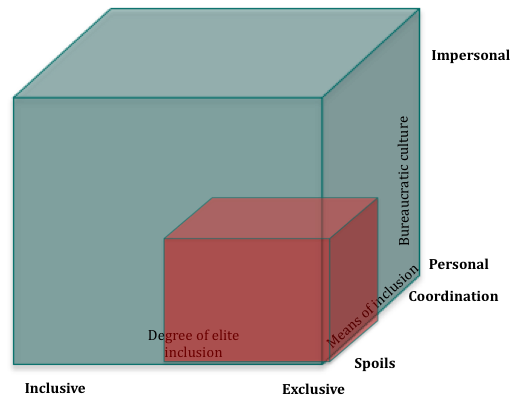
The most common type of settlement in today’s developing world lies between these extremes. The most powerful elites accept the basic terms of the settlement, but will be prepared to use violence or its threat at least some of the time; there may also be a minority of elites that are less accepting, for example regional or radical leaders, who use violence to try and achieve their aims on a more regular basis. Of the elites that accept the settlement, some are motivated primarily by spoils, some sign up to and are coordinated under a collective vision—perhaps of nationhood or even development—and some are motivated by both. The bureaucracy is permeated by patronage and nepotism, but civil servants are not entirely neglectful of their public duties; moreover, some pockets of excellence may be found. Cambodia, Uganda, Kenya and Indonesia, despite their differences, all basically conform to this type.
Such settlements are likely to have moderate developmental potential, and development partners are best advised to adopt a mixed portfolio of projects and programmes, working with state actors where the chances of traction appear high (often via islands of effectiveness), working with non-state actors where the state appears unresponsive or, as will often be the case, creating multi-stakeholder solutions that utilise both formal and informal institutions. They should also encourage, where this is not destructive of the settlement itself, or of broader security goals, an increasingly inclusive settlement. Here, the whole gamut of ‘doing development differently’ approaches can be drawn on, the aim being to gradually expand the size of the cube along all dimensions until such a time when more dramatic change may be possible.
Other noteworthy types
The above three settlements tend to have a kind of natural equilibrium, with each three sides of the cube balancing and reinforcing the other. However, less balanced, somewhat surprising, settlements do sometimes emerge, and these may be inherently more amenable to transformation (or deterioration).
Exclusive, spoils-driven, impersonal settlements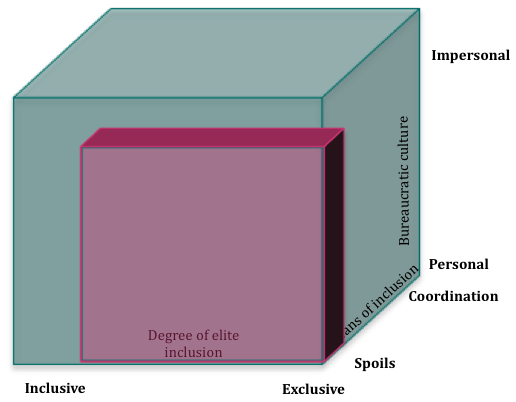
Take, for example, settlements that are relatively inclusive, where the elite is held together primarily by access to spoils, but where the bureaucracy recruits and delivers goods and services in a comparatively impersonal way. We think this configuration captures what we have elsewhere referred to as ‘developmental patrimonialism’, for example Côte d’Ivoire, Kenya and Malawi in the 1960s and 1970s, where a strong leader knits together the fragments of a nation, at least in part through the distribution of spoils, while providing protection for a comparatively competent bureaucracy fashioned under colonial rule.
These countries made better-than-average developmental progress for a while until, when the powers of founding presidents began to wane, the bureaucracy reverted to a more personalistic type. It is not inconceivable, however, that institutions could have been created to help better coordinate the elite around a common purpose, in the way that some more successful developmental states in Asia achieved. Whether or not development partners can play a role here is open to question—it is primarily a task for the domestic elite—but it is clear that they can sometimes make such coordination more difficult, for example by pressuring countries into premature democratisation. The issue is complex, however, since, sometimes, increased popular pressure, including for democracy, can help concentrate elite minds.
Exclusive, coordinated, personalised settlements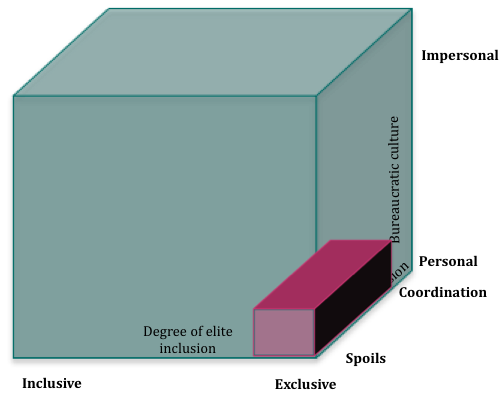
Another possibility is that the settlement is rather exclusive and the bureaucracy remains mired in nepotism and patronage, yet a narrow elite is coordinated around a common vision or goal, perhaps a developmental one. Such circumstances may be typical where a revolutionary movement or group has taken power. One would expect the new elite to be particularly keen to reform the bureaucracy in these circumstances, and to perhaps attempt to incorporate more elites into the settlement by demonstrating its ability to govern. Obviously, development partners will have to weigh up the pros and cons of supporting an at least temporarily unpopular and possibly quite coercive regime, but strong support for the core leadership in its efforts to maintain security and reform the state would seem to have potentially large developmental payoffs, albeit high risks too. Mozambique under Samora Machel might be an example of this type.
Exclusive, spoils-driven, impersonal settlements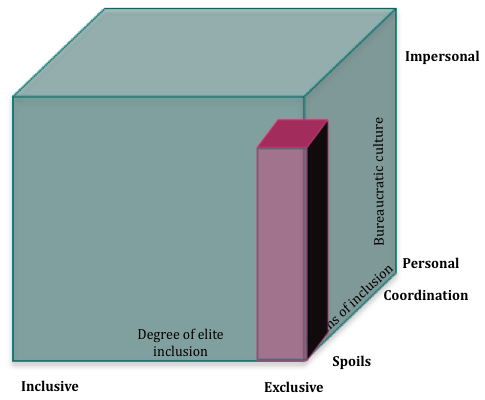
Another interesting type of settlement is exclusive and spoils-driven, but with an impersonal bureaucracy. Such settlements are most likely to emerge, perhaps, after a reasonably effective authoritarian state has been displaced by a feckless, and contested, democracy—post-1989 Bulgaria springs to mind. Assuming that a return to authoritarian rule is undesirable, development partners may be best advised to try to help shield the bureaucracy from the demands of spoils politics, while trying to nurture and then expand elite factions that look as though they may have a genuine interest in development. The kinds of parliamentary-strengthening programmes that attempt to build the maturity of the political class may be especially useful in this context.
Settlements in flux
Political settlements generally change rather slowly, evolving over time, until every so often a tipping point is reached, leading to a more or less prolonged period of upheaval or conflict, before a new settlement is formed.[7] During these periods, trying to take a reading of the ‘settlement’ may be more or less pointless. Things are in flux, and ‘all bets are off’, since anything and everything seems possible. Our political settlements tool can still provide a reference point for development partners, however. Insofar as they are able to influence events, policy advisors will want to try and encourage the emergence of a new settlement that not only is inclusive of the most powerful actors, but also is based on mechanisms for elite coordination, rather than a simple sharing of spoils. Although some transitional situations, such as the current one in Syria, will be highly intractable, development partners should take solace in the fact that others may be less so, and that it is precisely during these periods of flux that they may be able to wield their greatest influence.
Final thoughts
This is a first attempt to think through the implications of PSA for doing development differently, providing some pointers or compass bearings for in-country policymakers struggling to operationalise PSA. We stress that it is intended to provide some tips for where the smart money might be placed first, with the shape of the cuboid providing some pointers for which areas need the most attention and who the natural allies of development partners might be.
That said, when it comes to detailed programming decisions, a rough and ready diagnostic exercise such as this is just a first step, not a substitute for either detailed country knowledge or the ability to plan flexibly and design adaptively in light of changing situations and evidence-based feedback. The operational implications described above are intended to be tentative—supplemented, and in some cases superseded, by on-the-ground knowledge. This is particularly the case where there are disconnects between national and subnational or sectoral settlements, increasing the complexity of change processes and making it very difficult to map decision trees ex-ante.
As the evidence base expands, however, and both PSA and DDD approaches become more honed, so too ought our knowledge of what kinds of development programming work best in different country contexts.
[1] In fact, it is probably more accurate to think of political settlements as multi-level games, involving also national–subnational relations, whole government–sectoral relations, etc.
[2] See also a series of blogs on the Development Leadership Programme website, e.g. Jamar (2015), Laws (2015) and Teskey (2015).
[3] For example, Parks and Cole (2010) provide a more detailed template for political settlements ‘mapping’, which can also be extended to sectoral level. This and other PEA tools, such as power or stakeholder analysis, is likely to prove useful as country programming moves from the more general to the more specific level.
[4] By elites, we refer to individuals or groups with the ability to incite or organise a sustained campaign of disorder or violence.
[5] Most obviously, elite coordination may be geared towards something other than development, for example external war or internal security; even if it is geared towards development, it may not be of a particularly broad-based or sustainable kind. Further, even though powerful elites are included, less powerful ones, for example elite women or small ethnic minority leaders, may be excluded. And, even if it has the right intentions, its policymaking process may be rather ideological and inflexible, when it could be more problem-driven and iterative. Finally, the regime may come up short on most conventional measures of democracy.
[6] See Jones et al. (2012) for a useful discussion of ways development partners can assist fragile and conflict-affected settlements.
[7] See Parks and Cole (2010) for a useful discussion of how political settlements change.
References
Barder, O. 2012) ‘If development is complex, is the results agenda bunk?’. Owen Abroad Blog, 7 September, http://www.owen.org/blog/5872
Booth, D. (2015) ‘What next for political settlements theory and African development?’ Paper submitted to the ESID Synthesis Workshop, Midford, 8-11 November.
DFID (Department for International Development) (2010) ‘Building peaceful states and societies. A DFID Practice Paper’. London: DFID.
DFID (Department for International Development) (2013) ‘Country poverty reduction diagnostic’. London: DFID.
Di John, J. and Putzel, J. (2009) ‘Political settlements: Issues paper’. Birmingham: GSDRC.
Fritz, V. and Rocha Menocal, A. (2007) ‘Understanding state-building from a political economy perspective’. London: ODI.
Hickey, S. (2013), ‘Thinking about the politics of development: Towards a relational approach’. Working Paper 1. Manchester: Centre for Effective States and Inclusive Development.
Jamar, A. (2015) ‘DLP Political Settlements Workshop: Reflections’. Opinions. Birmingham: DLP.
Jones, B., Elgin-Cossart, M. and Esberg, J. (2012) ‘Pathways out of fragility: The case for a research agenda on inclusive political settlements in fragile states’. New York: Centre for International Cooperation.
Khan, M. (1995) ‘State failure in weak states: A critique of new institutional economics’, in J. Harris (ed.) The New Institutional Economics and Third World Development. London: Routledge.
Khan, M. (2010) ‘Political settlements and the governance of growth-enhancing institutions’. Draft Research Paper on Growth-enhancing Governance. London: SOAS.
Laws, E. (2012) ‘Political settlements, elite pacts, and governments of national unity’. Background Paper 10. Birmingham: DLP.
Laws, E. (2015) ‘What do we do on Monday? Political settlements in theory and practice’. Opinions. Birmingham: DLP.
Laws, E. and Leftwich, A. (2014) ‘Political settlements’. Concept Brief 1. Birmingham: DLP.
Leftwich, A. (2011) ‘Thinking and working politically: What does it mean, why is it important and how do you do it?’, in DLP (Developmental Leadership Programme) (ed.) Politics, Leadership and Coalitions in Development. Policy Implications of the DLP Research Evidence. Research and Policy Workshop, Frankfurt, 10-11 March.Background Paper. University of Birmingham: DLP.
Levy, B. (2014) Working with the Grain: Integrating Governance and Growth in Development Strategies. New York: Oxford University Press.
Levy, B. and Walton, M. (2013) ‘Institutions, incentives and service provision: Bringing politics back in’. Working Paper 18. Manchester: Centre for Effective States and Inclusive Development.
Lindemann, S. (2008) ‘Do inclusive elite bargains matter? A research framework for understanding the causes of civil war in Sub-Saharan Africa’. Crisis States Research Centre Discussion Paper 15. London: LSE.
Melling, J. (1991) ‘Industrial capitalism and the welfare of the state: The role of employers in the comparative development of the welfare state. A review of recent research’. Sociology 91(2): 219-239.
Parks, T. and Cole, W. (2010) ‘Political settlements: Implications for international development policy and practice’. Occasional Paper 2. Manila: The Asia Foundation.
Pritchett, L., Samji, S. and Hammer, J. (2013), ‘It’s all about meE: Using structured experiential learning (“e”) to crawl the design space’. Working Paper 322. Washington, DC: Center for Global Development.
Rocha Menocal, A. (2015) ‘Inclusive political settlements: Evidence, gaps and challenges of institutional transformation’. Birmingham: DLP.
Teskey, G. (2015) ‘Indonesia and the political settlements trap’. Opinions.Birmingham: DLP.
Whaites, A. (2008) ‘States in development: Understanding state-building’. Working Paper. London: DFID.
Whitfield, L. and Therkilsden, O. (2011) ‘What drives states to support the development of productive sectors? Strategies ruling elites pursue for political survival and their policy implications’. Working Paper 2011:15. Copenhagen: Danish Institute for International Studies.
Wild, L., Booth, D., Cummings, C., Foresti, M. and Wales, J. (2015) ‘Adapting development: Improving services for the poor’. London: ODI.
For more on Tim Kelsall, see our spotlight interview

